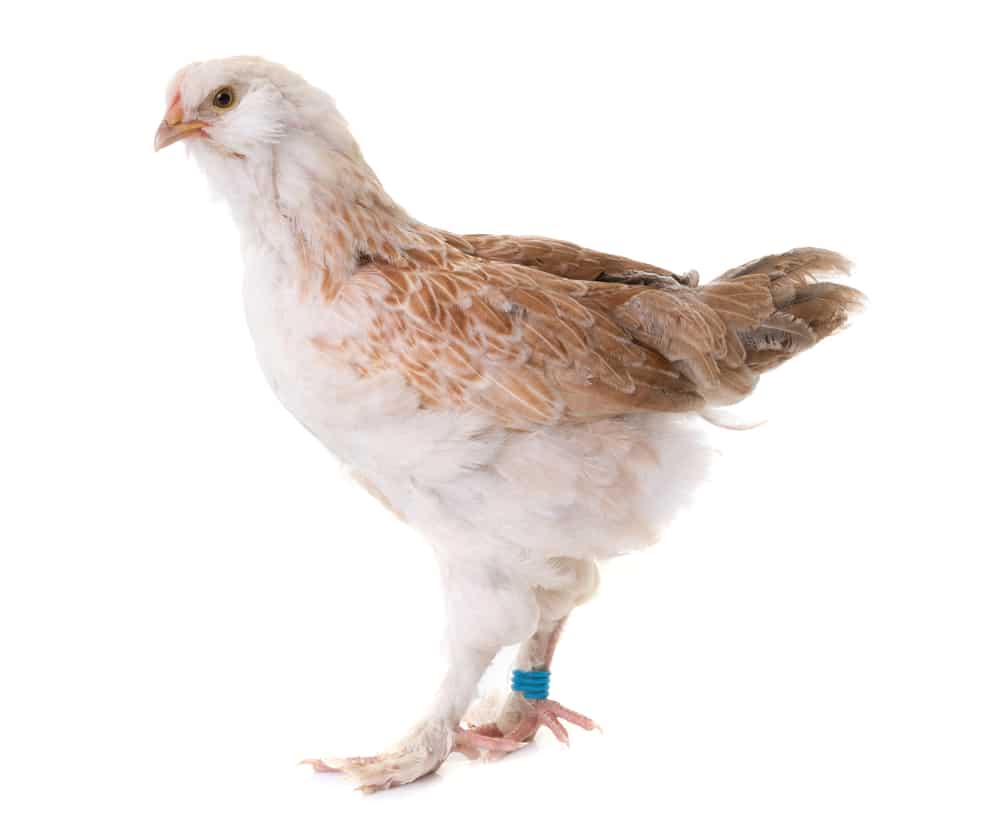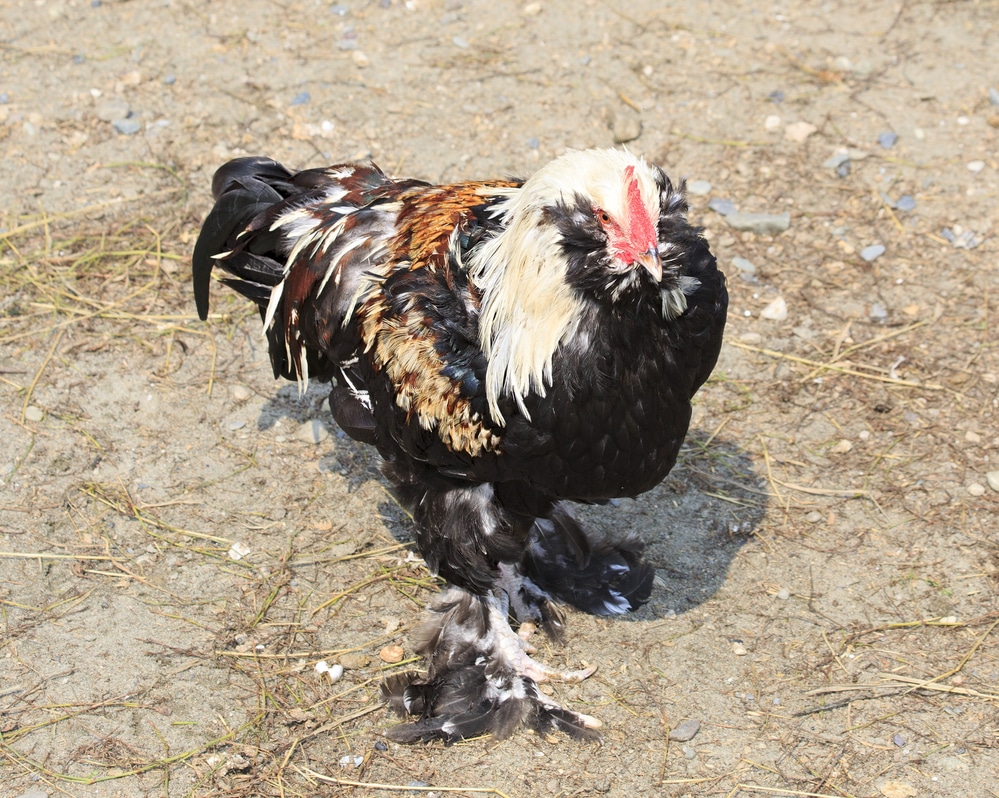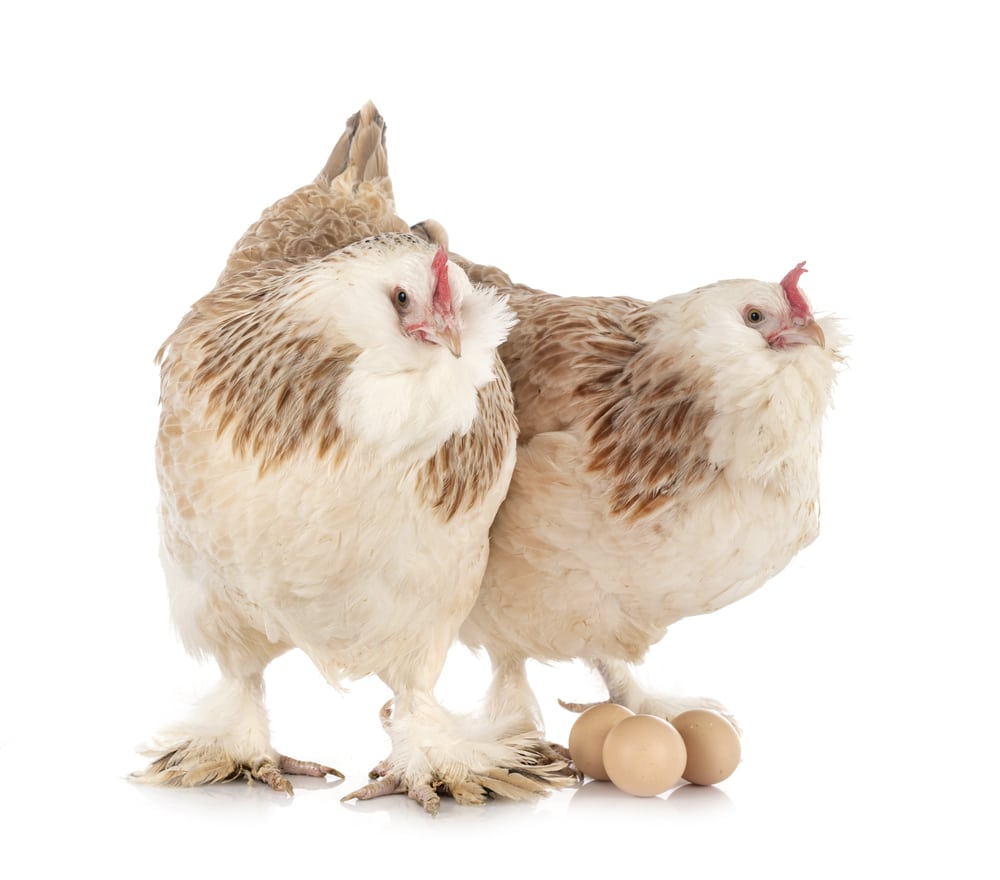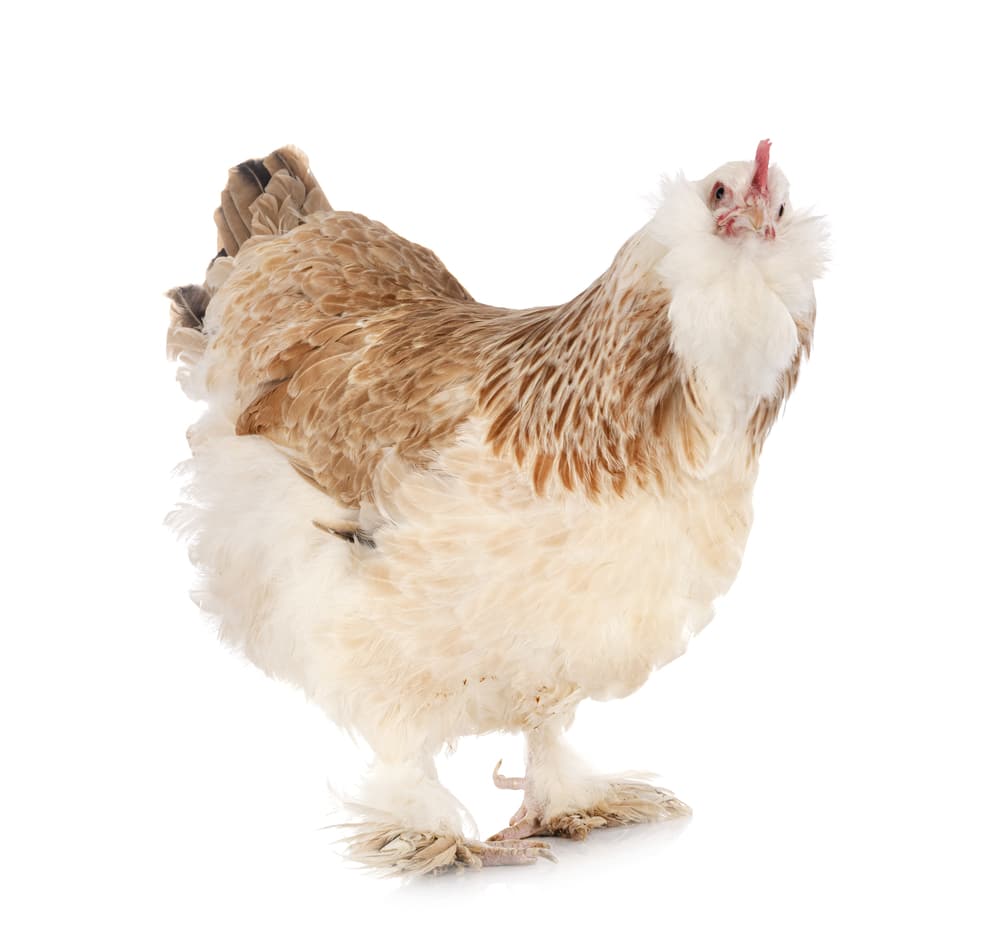In the market for an enthusiastic, high-spirited type of chicken? If so, the Salmon Faverolle might be the right choice for you.
This breed is happy-go-lucky chicken with a talkative personality and a curious demeanor, this chicken will enjoy spending much of its time chasing you around the barnyard in hopes of receiving treats!
Perfect for just about any backyard poultry owner, the Salmon Faverolle is the chicken you need to consider raising.
Let’s take a closer look.
Salmon Faverolle Overview
Here’s a quick overview of this breed’s characteristics to help you decide if this is a type of chicken you should consider.
| Lifespan | 5 to 7 years |
| Weight | 6.5 to 8 pounds |
| Appearance | Fluffy salmon-colored feathers |
| Egg Production | About 200 eggs per year |
| Egg Color | Light brown |
| Good for Beginners? | Yes |
| Minimum Habitat Size | 3 square feet per bird in coop, 10 square feet per bird outside |
| Price | $3 to $5 per chick |
Background of the Salmon Faverolle Chicken

With a unique name like “Faverolle” that slides right off the tongue, you might be curious about the history of the Salmon Faverolle chicken.
This breed first originated in a small village in France named Faverolles – hence the nomenclature. It has a unique genetic composition that is unclear to historians but is believed to be comprised of French Rennes, Malines, Dorking, Flemish cuckoo, Brahma, and Houdan.
It’s possible that other breeds were used as well, but it’s unclear since this breed has so many unique, distinctive genetic characteristics.
Whatever the origins were, the result was fantastic. French farmers wanted a chicken that grew out well for butchering and also yielded a respectable amount of meat – and that’s what they got out of the Salmon Faverolle.
At the time, the Houdan chicken breed was the most popular kind of chicken in France. It supplied most markets in Paris with all the eggs and meat they needed but it wasn’t well suited to confinement and had awful behaviors that, no matter what they tried, chicken producers could not break.
Producers wanted a hen that tolerated confinement better than Houdan chickens. Faverolles, when they first came on the scene, held up better to confinement and didn’t exhibit any of the bad behaviors of the Houdan. However, they also had excellent natural foraging ability, making them some of the best chickens on the market.
Faverolles were first brought to England in 1894. A UK standard was developed for the breed, and then later, in the early 1900s, they were imported to the United States by Dr. Phelps of Glens Falls, New York. Phelps did extensive work on refining the breed even further.
Appearance of the Salmon Faverolle Chicken

Most commonly kept for egg laying and meat production, the Salmon Faverolle is also an excellent choice if you are looking for an adorable, attractive backyard breed of chicken.
With a fluffy face and a five-point, single comb, the Salmon Faverolle has a deep, trapezoid-shaped body. It has a wide breast and back along with a deep keel. When standing upright, the Salmon Faverolle tends to puff out its chest, making it look much larger than it actually is!
Salmon Faverolles chickens have beaks that are pink or horn-colored along with eyes that are reddish-bay. They have rich, salmon-colored feathers (hence the name) all over their heads, backs, and wings, along with a breast that is speckled with white or straw-colored feathers. Both the muff, breast, and lower portions of the body are a pale cream color, with a gray underbelly.
Salmon Faverolles have loose, fluffy feathers – another feature that makes them look larger than they actually are. Their legs are feathered, too, and each foot has a unique set of five toes (this comes from the Dorking genetics). Legs and skin are both white.
However, what’s important to note is that the description provided above is just for Salmon Faverolle hens. Roosters are entirely different. Rooster will have black beards, black breasts, and black undercarriages, along with straw-colored saddles, backs, and hackles. Each wing has a luxurious gold color with triangular white tips.
The tails of roosters contain beetle-green, iridescent feathers, along with black leg feathers. Roosters weigh, on average, about eight pounds, while hens weigh about six and a half. When all of the unique characteristics of the two different genders are examined, it is incredibly easy to tell the two apart! Hens are quite different from roosters, and vice versa.
There are several recognized color varieties of the Faverolle chicken. Of course, this article deals primarily with the salmon color, but the other recognized variant in the United States is the White Faverolle. Salmon was recognized by the American Poultry Association in 1914, while white was recognized in 1981.
There are other varieties that aren’t recognized, too, including:
- White
- Ermine
- Splash
- Cuckoo
- Blue
- Black
The Salmon Faverolle is classified as a continental breed, while other agencies, like the ABA and the PCGB< recognize it as either feather-legged or soft feather, heavy.
There are also bantam Faverolles that you can purchase. Developed in 1925, these birds are incredibly small – females weigh only 26 ounces, while males are just 30.
Behavior of the Salmon Faverolle Chicken
Salmon Faverolle roosters are known for being quite docile and calm. They are not known for being aggressive and are instead gentle and graceful as they go about their daily business.
Instead, Salmon Faverolles are quite friendly, comical, and fun to watch. They enjoy running with abandon throughout the chicken run, and get along easily with other chickens – including those of other hens. They’re known as one of the friendliest types of chickens.
They are one of the best chicken breeds to consider if you are raising chicken as pets. They are cuddly and docile and remarkably easy to train. They are also quite vocal, which is something to be aware of if you are trying to raise a flock of chickens in the city or near closeby neighbors.
Because Salmon Faverolles are so gentle and unassuming, it’s not recommended that you keep them in a flock of aggressive chickens. They tend to be right at the bottom of the pecking order and are easily bullied by more aggressive hens.

Faverolles Chicken Productivity
This section should give you a general idea of the type of egg & meat production that you can expect out of Salmon Faverolle chickens:
Egg Production
Faverolles of all kinds are prized because they tend to mature more quickly than birds of other breeds. In fact, once they start their egg laying process, they will produce for quite some time, laying all through the winter months, in fact.
Salmon Faverolles produce up to 200 light-brown or tinted eggs each year. These are medium-sized, with each hen usually producing about four eggs each week.
While some people say that Salmon Faverolles chickens are known for becoming broody, others say it is not common – when considered as a whole, this type of chicken is probably just about average. If you do have a Salmon Faverolle go broody – and you don’t want her to – rest assured that this breed is relatively easy to break.
When allowed to set, though, Salmon Faverolles are good setters and excellent mothers.

Meat Production
Salmon Faverolles are commonly raised for meat. Mature roosters weigh anywhere between eight and ten pounds, while hens tip the scales at around six. This varies depending on where you are raising your birds, what you are feeding them, and how long you let them grow, of course.
A disadvantage of keeping Salmon Faverolles, or Faverolles of any kind, as meat birds is that they take quite some time to mature. As a result, the meat can become tough and less palatable as you wait. It’s recommended by many expert Faverolle producers that you instead butcher your meat birds sooner rather than later. You will lose a bit of your yield, but you will save money in feed expenses – plus, you’ll receive a much tastier, more tender carcass.
Common Issues with Salmon Faverolle Chickens
Salmon Faverolle chickens aren’t more likely to contract certain diseases than other breeds of chickens. However, they are more prone to lice and parasites.
For the most part, this has to do with the fact that the feathered legs and beards of the chicken provide an excellent hiding spot for these pests. You may need to check your Salmon Faverolle chickens on a regular basis to make sure your flock is not infested.
Providing your chickens with access to a dust bath can help reduce the likelihood of a lice infestation, as can dusting your chickens on a regular basis. Just be careful as you are doing this around the beak and eyes, as it can be a bit irritating.
The legs of the Salmon Faverolle, since they are feathered, are also prone to developing bad scaly leg mite infestations. The feathers make it challenging to spot until the problem is well-advanced, but if you check on a regular basis, you should be able to keep things controlled.
Otherwise, Salmon Faverolles are healthy and robust – most live up to seven years when properly cared for.
Benefits and Drawbacks of Raising Salmon Faverolle Chickens
Here are some common benefits / drawbacks of raising Raising Salmon Faverolle chickens:
Benefits
There are plenty of excellent reasons to consider raising a Salmon Faverolle in your backyard flock.
Not only are they funny and enjoyable to watch, but they are absolutely beautiful and incredibly gentle. They are one of the best chicken breeds to consider if you have small children – even the roosters are remarkably laidback.
Salmon Faverolles are great companions and enjoy being held, cuddled, and kissed. They aren’t likely to peck or scratch you and instead are both peaceful and charismatic.
Another benefit of raising the Salmon Faverolle is that it does not require a high fence to stay contained. It is not a great flyer and does quite well in confinement. They can fly, but they aren’t known for being flight. However, if you want to allow your Salmon Faverolles to free-range, you’ll have good luck with that, too – these chickens are excellent foragers and do just fine when given the opportunity to fend for themselves.
Excellent layers, Salmon Faverolles tend to produce eggs all throughout the winter months. They also dress out nicely if you are looking for a good chicken breed for the dinner table.
Salmon Faverolles are also reliable producers for the dinner table, producing five to ten pounds of meat per each mature bird.
This breed is one of the most cold-hardy chicken breeds you can raise, too. With its dense feathering and moderately heavy build, it can withstand anything winter throws at it. It also has a single comb, which makes it less likely to suffer from frostbite when the temperatures plummet,
Challenges
One of the biggest challenges of raising a Salmon Faverolle goes hand-in-hand with one of its major benefits – this chicken is so docile and gentle that it can easily become the target of other, more aggressive hens. Therefore you need to exercise caution when introducing Salmon Faverolles to a mixed flock, as they can find themselves the targets of aggression.
Despite their cold-hardiness, Salmon Faverolles aren’t known for being exceptionally heat-hardy. They don’t do well in the hot summer sun, particularly because of the dense feathering that covers the entirety of their bodies, so you will need to provide some supplemental shade. Clean, fresh water is also essential to keep these chickens nice and cool.
Although Salmon Faverolles are remarkably cold hardy, you will need to do some extra work in the winter to make sure their feathers (and particularly their legs and feet) remain dry at all times. Since they have so many feathers there, it is easy for them to become chilled or develop frostbite.
Another thing to note about the Salmon Faverolle – though not necessarily a challenge and more of a consideration – is that you may have some trouble finding these birds. They aren’t incredibly common at most farm and garden stores in the United States, but luckily, chicks or hatching eggs can be purchased from many only hatcheries.
If you are breeding any kind of Faverolle for exhibition, you will want to make sure you select the correct hen and rooster bloodline. Since they are considered “threatened” birds, you need to make sure that the breeding was done with any rules set in place by the Livestock Conservancy.
As mentioned, Salmon Faverolles are somewhat rare in America. You may be able to find them at internet hatcheries, through live poultry outlets, or even through specialty farms. You can also check with the Faverolle Breeders Club of registered breeders with good, legitimate stock near you.
Finally, since Salmon Faverolles are so outgoing – and not particularly flighty or cagey – you may have to put some extra precautions in place when it comes to predators. Although these birds have decent eyesight, they aren’t great at flying and may have a more difficult time getting away when the need arises.
That’s why it’s important to resist the temptation to erect shorter fences for your Salmon Faverolles, just because you know they won’t be able to fly over them. Just because they can’t get out doesn’t mean that something else can’t get in – and that could spell disaster for your flock. Your best bet is to cover the coop completely to make sure they are secure from predators.
How to Raise a Salmon Faverolle Chicken
When it comes to raising Salmon Faverolles, there’s not much extra that you need to do to keep them happy. Give about two to three square feet per chicken in the chicken coop and another ten feet in an outside run – more is always better.
Even though Salmon Faverolles aren’t the largest chickens and bear confinement well, providing plenty of space can reduce the likelihood of aggression (which can lead to pecking, bullying, and even cannibalism).
Feed your Salmon Faverolles any commercial chicken feed that you would normally feed your flock, and feel free to supplement their diet with kitchen scraps, garden foraging, and other tasty morsels.
Salmon Faverolles are happy in any size flock as long as the other chickens do not bully them. You’ll want to make sure the cop has plenty of space for nesting boxes (at least one box for every four hens) and roosting rails that are at least an inch and a half wide.
Although adequate roosting bars are important for chickens of all breeds, they are especially important for Salmon Faverolles. Because of their feathered legs, they can become chilled more easily – making sure the roosting bars are wide will ensure that your chickens can hunker down and use their body heat to warm and dry their legs.
Similarly, you will want to make sure your chicken coop is well-ventilated. Too little ventilation can lead to a humid coop, while too much of a draft can cause temperatures (and overall flock health, as a result) to plummet. You may want to consider raising the coop off the ground to give the chickens a dry place to roost and lay their eggs, especially in periods of wet weather.
Frequently Asked Questions
Before your decide if this type of chicken is a good fit for you, it’s a good idea to get all your questions answered. So, here are a few things that new chicken keepers commonly wonder.
Are Salmon Faverolle Roosters Nice?
Yes, Salmon Faverolle roosters tend to be friendlier and more docile than roosters of other breeds. They’re rarely aggressive and are often described as gentle and graceful. However, this means they’re low on the pecking order, so avoid keeping them with roosters of more aggressive breeds.
Are Salmon Faverolle Chickens Bantams?
No, Salmon Faverolles aren’t bantams, but they can be. Bantams are described as a chicken of a small breed. So, you can purchase small versions of these birds, which weigh between 26 and 30 ounces. The males are usually heavier than the females.
How Long Do Salmon Faverolles Live?
Most of these chickens live between 5 and 7 years. However, the lifespan of a chicken can always affect how long it lives. If the fluffy feathers of this breed aren’t maintained, they could face more health concerns, so check them often for parasites.
Is the Salmon Faverolles Right For Me?
Sadly, despite all the great reasons to raise a Salmon Faverolle chicken, this breed remains at the top of the Livestock Conservancy’s list of threatened breeds. Luckily, it’s becoming more popular with backyard chicken keepers who are interested in raising heritage breeds, so there is some hope that one day it will leave the list entirely.
In the past, this chicken was kept as an ornamental breed – but there’s really no reason to limit yourself! The Salmon Faverolle has stellar egg laying and is also a decent meat producer. Plus, it’s a phenomenal pet.
What more reason do you need to raise this energetic, enthusiastic chicken breed?
